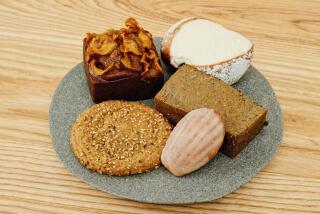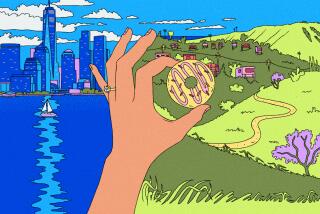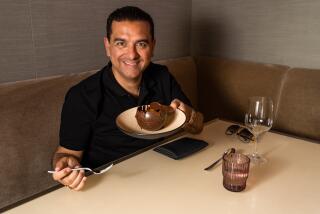How to describe the Donut Man’s strawberry specialty? Great taste, messy filling
- Share via
It is a union of glaze and gluttony, of fresh and fried, of fruit and fat.
Displayed behind the glass of a humble food stand, it is breakfast, a midday snack, a dessert, a craving.
Behold the Donut Man’s strawberry doughnut.
Photos: The Donut Man’s glaze of glory
For nearly four decades, this clamshell of fried dough stuffed with a gooey mess of strawberries has kept a small Glendora shop thriving. Weathering tough economies, health fads and breakfast competition from the bagel and Egg McMuffin as well as upscale brethren like croissants and scones, it remains a sought-out gem.
Situated on a forgettable strip of old Route 66, the Donut Man is little more than a shanty with a takeout window and four gnarled benches. Still, it beckons 24 hours a day to lingering locals, snap-happy tourists and college kids with the midnight munchies.
Regulars come for the sweets and stay for the lighthearted conversation offered by 71-year-old Jim Nakano — the Donut Man himself.
Nakano and his wife, Miyoko, began selling the seasonal strawberry doughnut in 1974, following it with another hit: the peach doughnut.
Although the fruity foodstuffs are bestsellers, the shop has also earned a reputation for its tiger tail — a foot-long glazed twist with a ribbon of chocolate — and receives raves for its Bavarian creams and maple bars. With the treats came lore: Roy Rogers ordered a buttermilk bar before heading out on hunting trips. Elvis Presley, a jelly man, sent his karate instructor to pick up raspberry-filled doughnuts.
Nakano believes his high-end ingredients are why he hasn’t felt the recession’s pinch. He avoids artificial flavors, concocts his own fillings, even roasts his own coffee beans. As for the base of his doughnuts, he says the magic is in the potato flour, wet yeast and soybean shortening used for frying.
“It’s so important to keep the shortening clean and get it to the right temperature,” Nakano said. “When I come in, I’ll break open several doughnuts to see if they were made right. If it’s greasy, I’ll throw it out. I’m very hardheaded; I won’t scrimp. I think that’s why we’re successful. I’ll kick up the price, but I won’t lower my quality. Mainly because I eat the doughnuts too.”
On a two-doughnut-a-day diet, Nakano is trim and youthful, eager to banter with customers and delivery people. He’s at the shop by 6:15 a.m., sometimes after a 60-mile round-trip drive to downtown Los Angeles to pick up crates of fresh fruit. Hopping onto a countertop, he’ll sit and hull strawberries for several hours, sidetracked by such tasks as fixing the cash machine or taking orders.
A third-generation Japanese American whose grandfather worked on a pineapple plantation in Hawaii, Nakano can’t help but contrast his regional fame with his impoverished past.
Born in Boyle Heights, Nakano was 2 when he and his parents were sent to an internment camp in Poston, Ariz. He has vague memories of the sweltering tarpaper shacks where thousands of Japanese Americans were imprisoned during World War II. Even though the family was incarcerated, his father was drafted into the Army.
Released three years later, Nakano and his mother found that no one would rent to them, so they went to live with a white family they had befriended before the war. Eventually, they moved into Section 8 housing in San Pedro. His mother found a job at a cannery. Nakano fought off racist taunts in a community with few Japanese Americans.
After his father was discharged and got a job selling wholesale produce, the family moved to East Los Angeles. Nakano studied marketing at Cal State L.A., then joined the Navy, requesting to be stationed in Japan so he could meet his paternal grandparents. After he returned, he became a department manager at a JC Penney store.
While on vacation in Europe, Nakano met a Japanese woman on a train. The two ended up traveling across the continent together. His Japanese was nonexistent, but Miyoko spoke English well. Eight months later they married.
It was Miyoko’s idea to open the doughnut shop, reasoning it would take little start-up cash and provide a better paycheck. They bought the rights to a Foster’s Donuts franchise in 1972 and opened for business. Nakano manned the fryer; his wife, the window.
Later, a friend who grew strawberries suggested Nakano add them to his menu. Another friend who owned a Marie Callender’s helped him perfect a recipe for the ruby-colored gel. The result was a massive glazed doughnut that required a fork. Bright and beautiful, it slowly drew a cult-like following.
Then, when strawberry season ended, Nakano turned to fresh peaches. Later, he introduced a pumpkin-filled doughnut. Hoping for even more creative freedom, Nakano and his wife bought the franchise. In 1985, Nakano was dining at a restaurant when a little girl noticed him and exclaimed, “It’s the doughnut man!” The name stuck.
Still, winning customers’ appetites was challenging, especially as fast-food chains and supermarkets began offering more breakfast items and baked goods. A 1999 PBS segment about the Donut Man helped the shop gain a following outside the northeastern San Gabriel Valley.
Eventually it became a destination for foodies and travelers. Students at nearby Azusa Pacific University and from as far as Claremont and Pomona proved religiously loyal — spreading the gospel of the $2.90 strawberry doughnut to incoming freshmen. Every spring, Nakano rewards a group of unicyclists from Harvey Mudd College with doughnuts and drinks for making the 9-mile ride.
His wife and their son, Justin, don’t put in time at the shop anymore, but Nakano says he would be bored staying home. And although his memory has begun to fade and he sometimes has trouble matching names with faces, he can’t fathom giving up the business and the title that comes with it.
In winter, business drops off a bit. Nakano has experimented with other fruit-filled pouches, but they were too labor-intensive, didn’t hold up well or had too short a season.
This year the strawberry doughnuts appeared in February. Gauging from the weather, he estimates the berries will hold out for a couple of weeks longer. Faithful customers know that on rare occasions, one seasonal item will overlap with another.
Already, the phone calls and Facebook queries have begun: Hey, Donut Man, when does peach season start?
Photos: The Donut Man’s glaze of glory
More to Read
Sign up for Essential California
The most important California stories and recommendations in your inbox every morning.
You may occasionally receive promotional content from the Los Angeles Times.











